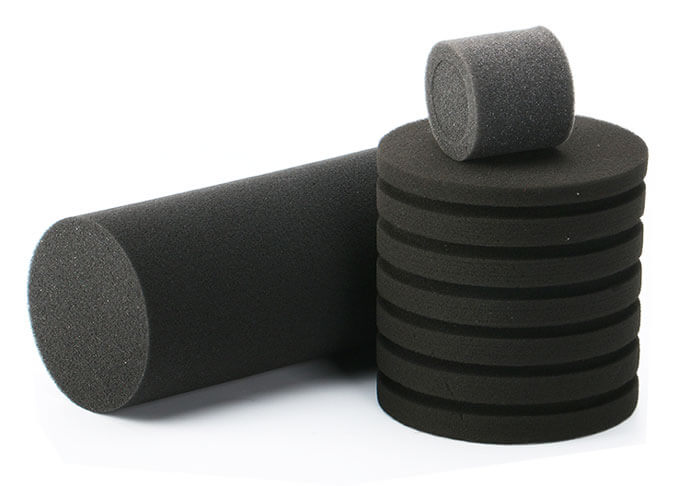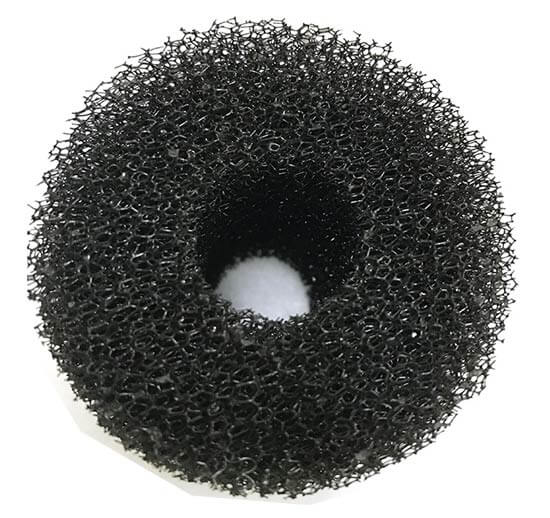Foam Material family is a HUGE group which can be categorized in many ways and types. For you easily, all foam materials can be either open cell foam or closed cell foam.
It might be complicated for you to learn what exactly they are in a short time. But after going through this post, you will easily find out what are open cell foam and what are closed cell foam. Another bonus is you can get to know the comparison between the 2 different types of foam material, and can choose wisely for your applications.

Foam materials are versatile, lightweight and durable, which makes them ideal for usage across many industries.
WHAT IS OPEN CELL FOAM?
Here we are going to elaborate open cell foam materials from some aspects in detail.

Polyurethane foam is one of the most frequently-used open cell foams. They are widely used in insulation, sound and shock absorption application across a range of industries and materials, including furniture upholster, seat cushion, medical packaging, electronics, power equipment and so much more. Open cell Polyurethane foams are superior to other forms of insulation for their dexterity and resistance to oxygen.
You might be puzzled to hear that something solid is also made of Polyurethane foam. The fact is actually that Polyurethane foam comes in two forms- open cell or closed cell structure, both of which differ in densities and respective applications. However, in this post, we focus on open cell Polyurethane foam materials.
Besides Polyurethane foam can also be provided in open cell structure. PVC/ Nitrile foam and EPDM foam rubber are available for open cell foams as well.

Open cell foams take Polyurethane foam sheets as an example where the cells within the material have been broken, allowing air to occupy the spaces within. Usually open cell foams are lightweight and less dense compared with closed cell foams, and they have a soft, cushioning and sponge-like appearance.
During an open cell foams expansion and curing, the gas bubbles used in its production are released into the atmosphere as against being locked in place as with closed cell foams. These holes within open cell foams enable them to interlock and interconnect. Due to this porous nature, open cell foams can not resist liquid water or water vapor.
WHAT ARE OPEN CELL FOAMS MADE OF?
There are an array of open cell foam materials, but generally they are made of Polyurethane, reticulated Polyurethane, PVC/ Nitrile, EPDM rubber etc..
FEATURES AND ADVANTAGES OF OPEN CELL FOAM

Some of the features and benefits of the open cell foam include:
-
It doesn’t contain any volatile organic compounds or ozone depleting gases
-
It is ideal for minimizing noise transmission
-
It produces little or no residual particles, and traps most foreign particles in its pore spaces, making it ideal for reducing dust and allergens
-
It is mold growth resistant
-
It is good at sound proofing
-
It has a good insulation value of approximately R-4.21 per inch
-
It accounts for about 40-50% of heat gain/loss in apartments
-
It is durable and will not break, shrink or diminish over time
-
It has a high expansion capacity, capable of expanding up to 100 times
-
It has a low density of between 0.4 and 1.2 lbs./ft3
USES OF OPEN CELL FOAM

Open cell foam can be used for a wide range of construction purposes including:
-
Low cost furniture upholster
-
Interior design projects
-
Sound proofing for buildings
-
Foam protective packaging
-
Vapor, moisture and air permeable required application
WHAT IS CLOSED CELL FOAM?
Closed cell foam is a strong, flexible plastic rubber material that’s made up of internal pores or cells. These internal cells of closed cell foam sit closely together but are not connected. Closed cell structure can be compared to a net filled with bubbles, where the balloons are trapped tightly against each other, but each of the bubbles are not interconnected.

Also closed cell foams are more frequently used from various industries including construction, packaging, marine, electronics, automotive and so on. The typical closed cell foam materials include EVA foam material, Polyethylene foam, Neoprene foam, PVC/ Nitrile foam rubber, SBR foam rubber and so on.
WHAT ARE CLOSED CELL FOAMS MADE OF?

The materials which can be used to produce the closed cell foam vary greatly from EVA, polyethylene, polystyrene, rubber to polypropylene etc.. The closed cell foam principally contains trapped gas bubble which are formed during the expansion and cure of the foam. These bubbles constitute a blowing agent. They are permanently locked to a place, as the trapped gas is very efficient in increasing the insulation capability of the foam. The foam which is formed is strong and is usually of a medium density which enables the gas bubbles to lock into place. The nature of the foam enables it to be vapor retardant and resist liquid water.
FEATURES AND ADVANTAGES OF CLOSED CELL FOAM

The features and advantages of the closed cell foam include:
-
Helpful and extremely reliable to be used in both exterior and interior environments
-
Helpful in increasing the structural strength
-
Best for providing heat and sound insulation
-
Effectively Reduce the vapor transmission
-
Superior moisture barrier
-
Excellent resistance to leakage
APPLICATIONS OF CLOSED CELL FOAM

There are a lot of applications for the closed cell foam. They can be quite useful for a variety of application which requires moisture & shock resistance and heat & sound insulation. Closed cell foam as well as the sponge rubber products are extremely popular with the insulation, cushioning, padding and gasketing application for years. And the applications of closed cell foam are limitless. It is also used as a means of custom foam protective packaging which are used to safely store and present fragile jewelry, tools and electronics etc.. They offer excellent protective cushioning, moisture and air resistance as well, which prevents the moisture from gathering inside the package, making it the best choice for safely storing delicate machinery for longer period of time.
The typical applications for closed cell foam includes:
-
Insulation and sealing for construction and building
-
The appliances and HVAC system
-
Thermal insulation and shock absorption
-
The seals of enclosure and cabinets
-
The medical disposables
-
The equipment of gas and oil
-
Aerospace and aircraft
-
The transportation and automotive
COMPARISON BETWEEN OPEN CELL FOAM & CLOSED CELL FOAM
Foam materials are a kind of cellular product . The structure of its cell and especially the contents of its cells, whether open or closed , will have a significant influence on the performance of the product and its final applications.
Although open cell foam and closed cell foam may present similar appearances, they should be treated as two different products as their properties and performance are totally different.

While a closed-cell foam contains more than 90% closed cells, for open-cell foam, of which there is as yet no official definition, the figure is usually below 20%, although it may have higher proportions. Open cell and closed cell foam have indeed some common features such as shock absorption, thermal insulation and noise deadening etc.. Generally speaking the distinguishing feature is that the ” Closed Cell Content (CCC)” directly influences the fundamental properties of the foam, such as tear strength, thermal conductivity, average density, water absorption and watertightness, vapor permeability or compressive strength.
You could check out the main differences between open cell foam and closed cell foam as below:
-
Foam Structure

Apparently the different foam structure is the most obvious difference between closed cell foam and open cell foam. Closed cell foam is formulated with tiny closed cells, and it present a strong, solid appearance. But open cell foam shows a uneven and lightweight appearance so that you can easily discover the open cells all around the open cell foam materials.
-
Foam Density
Closed cell foam usually has heavy weight compared with open cell foam. Closed cell foam has closed cell structure and they can keep almost their initial weight before foaming process, but open cell foam can not compete on that. The open cell structure has release a large part of their weight after foaming process.
-
Moisture, Air, Liquid Resistance

When you want to distinguish closed cell foam from open cell foam, you can take another quick and smart method. It is simple and easy by just pouring some amount of water on both types of foam materials. You can suddenly find out one type of foam absorb water and take water inside the tiny cells. But the rest one do not absorb water and keep water out from their surface. So now you might know the first one is open cell foam and the rest one is closed cell foam.
The voids in the open cell foam intersect each other, forming paths through the solid. Closed cell foam consists of individual closed areas, so air or liquid can not penetrate this type of foam. They have different performance in face of moisture, water, air and other liquid due to their foam structures.
-
Material Cost
Open cell foam usually involves a lower cost of material in use. The most popular open cell foam material is polyurethane foam and reticulated polyurethane foam. Partly because of their low cost, they have been frequently used for furniture upholstery, seat cushion, carpet underlayments, foam filters. While closed cell foam usually provide better performance on insulation and durability, it is also leads to a higher material cost.
-
Thermal Insulation and Sound Insulation

Considering heat insulation, closed cell foam materials can typically outperform open cell foam materials. Closed cell foam has lower thermal conductivity such as Polyethylene foam so that they can be widely used for roofing and flooring insulation applications. But meanwhile open cell foam can offer excellent sound absorption than closed cell foam. As they have many tiny open cell structure, this can make them very powerful and effective to take in the lots of external sound or noise. You can find open cell convoluted PU foam used as sound proof foam for broadcasting studios and conference rooms etc..
-
Different Applications

Open cell foams are generally soft and compressible. Foams with open cells act as good insulating entrapment of air inside the cells. Foams with open cells, like a sponge dish brush are able to absorb the liquid in their cells. Closed cell foams can provide greater structural rigidity, and because the cells are closed, the cells can be filled with gases other than air during manufacturing. Closed cell foams can be used to prevent water or air from moving from one area to another. Also open cell foam is often used for its absorption qualities, particularly for sponges. Open cell foam is also used in a variety of insulation applications because of its low cost value. Open cell foam can also be used for sound dampers, shock absorbers, cushioning and pillows.
Closed cell foam is often used in flotation devices, since its closed cell structure does not absorb water and trapped air is energetic. And Closed cell foam is often used in other applications that require water resistance, such as neoprene suits, mats, gaskets and insulation. It is denser than open cell foam and generally more expensive to produce.

TIPS & GUIDES FOR CHOOSING RIGHT FOAM MATERIALS
If you want a waterproof foam? Go for closed cell foam
If you want a excellent soundproof foam? Go for open cell foam
If you has limited budget for foam? Go for open cell Polyurethane foam first to see if it is workable
If you want foam with excellent thermal insulation? Go for closed cell foam
If you want foam with excellent resilience and durability? Go for closed cell foam rubber
TYPICAL OPEN CELL FOAM MATERIALS & CLOSED CELL FOAM MATERIALS
Here we are listing some typical foam materials categorized in two types:
Open Cell Foam: Polyurethane Foam, Reticulated Polyurethane Foam, Open Cell Nitrile Foam, Open Cell EPDM Foam
Closed Cell Foam: EVA Foam, Polyethylene Foam (EPE Foam, XLPE Foam), PVC Foam Rubber, Neoprene Foam Rubber, SBR Foam Rubber, Closed Cell PVC/ Nitrile Foam, Closed Cell EPDM Foam Rubber
So now we hope next time you can be easy to choose between open cell foam and closed cell foam. Any further question concerning this, just feel free to let us know.







Are both open and closed cell PU foam use the same chemicals?